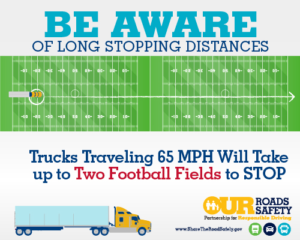With more than 70% of the nation’s freight shipped via commercial truck carriers, today’s truck drivers are literally driving the U.S. economy. Jobs in this profession have never been in more demand, with abundant opportunities to work at some of the best companies.
But if you want to keep your truck driving job options rosy, a safe driving record is critical. Shipping fleets know that safe drivers are more cost efficient, so they are looking to hire drivers with a stellar record. Some companies are even offering incentive pay for employees who steer clear of accidents and incidents.
Chicago Daily Herald–”Truck driver gets 4 years in tollway crash that killed 8.”
Top Tips for Truck Driving Safety
1. Always conduct pre and post-trip inspections.
“An ounce of prevention is worth a pound of…”; you know how the saying goes. This is especially true for professional truck drivers. While many drivers might rely on their company’s mechanics to keep their rigs in tip top shape, with your livelihood and life at stake, you should always take personal responsibility for making sure your truck and trailer are in good repair and road worthy. This includes making sure that tires are properly inflated, brakes are adjusted, and lights and mirrors are in working order.
2. Plan your trip and know your route.
Take time to plan your route in advance, taking into account terrain, weather, traffic congestion, and construction delays. In addition, don’t rely solely on Google Maps and GPS to plan your route. Non-motor carrier route guides do not take into account low bridge and tunnel clearances, in addition to bridge weight restrictions. Pay attention to road signs and reference your motor carriers’ atlas to make sure your route is passable for your rig.
3. Get Out And Look (G.O.A.L.) when backing up.
When space is tight or you simply can’t see a potential strike point, the best practice is to Get Out And Look. It may seem tedious, but getting out of your truck to asses the location of stationary objects, such as other vehicles, walls, concrete posts, or dock protrusions in relation to your rig can prevent many accidents. It may take a few minutes of your time, but consider how many hours of time are lost due to an accident.
4. Don’t drive distracted.
We all know that texting while driving is a no-no. But many other distractions can lead to accidents. These can include:
- Adjusting music and electronics
- Using cell phones
- Eating and drinking
- Reading maps and directions
- Smoking
- Caring for a pet
The best way to avoid distracted driving is to make sure you have your cab organized for your comfort before you get on the road. If needs arise while on the road, it’s best to stop rather than risk an accident.
5. Adjust your speed for conditions.
Even if you aren’t tailgating or speeding, your following distance could be too close to brake and stop. Stopping distance can be affected by many variables, such as the weight of your load, traffic, sunlight, construction zones, weather, and road hazards. Remember that total stopping distance includes the time it takes to perceive the hazard, react, brake, and for most rigs with air brakes, for the brake system to fully engage. Many of the trucking accidents causing the most deaths have occurred because a truck driver was following other vehicles too closely and could not stop in time to avoid a collision.
6. Stay between the lines at all times.
This applies to both your cab AND your trailer. You aren’t driving safely if your trailer leaves the road or drifts outside of the lines. And while you may be tempted to swerve to miss an animal, it’s not worth the risk to your life and the motorists around you. WIth 80,000 pounds of force, your rig is like a loaded weapon to those around you. Stay between the lines and stay on course to prevent injuries and fatalities.
7. See and be seen.
Road hazards, slow traffic, and pedestrians can be difficult to see at night, during dawn and dusk, or during inclement weather. Always keep your windows and mirrors clean and consider using polarized sunglasses to reduce glare during dawn and dusk. Similarly, it’s important that you make sure you are seen by others. Consider using lights during dawn and dusk hours, in addition to at night. Use flashers if you have to slow down suddenly or are traveling at speeds significantly lower than posted.
For more helpful tips on big rig safety, visit the Federal Motor Carrier Safety Administration’s site.
